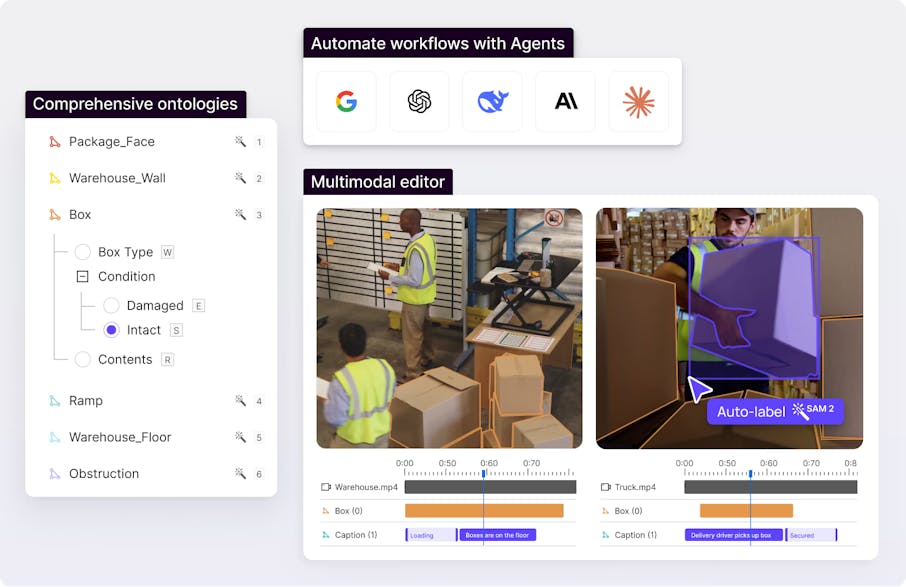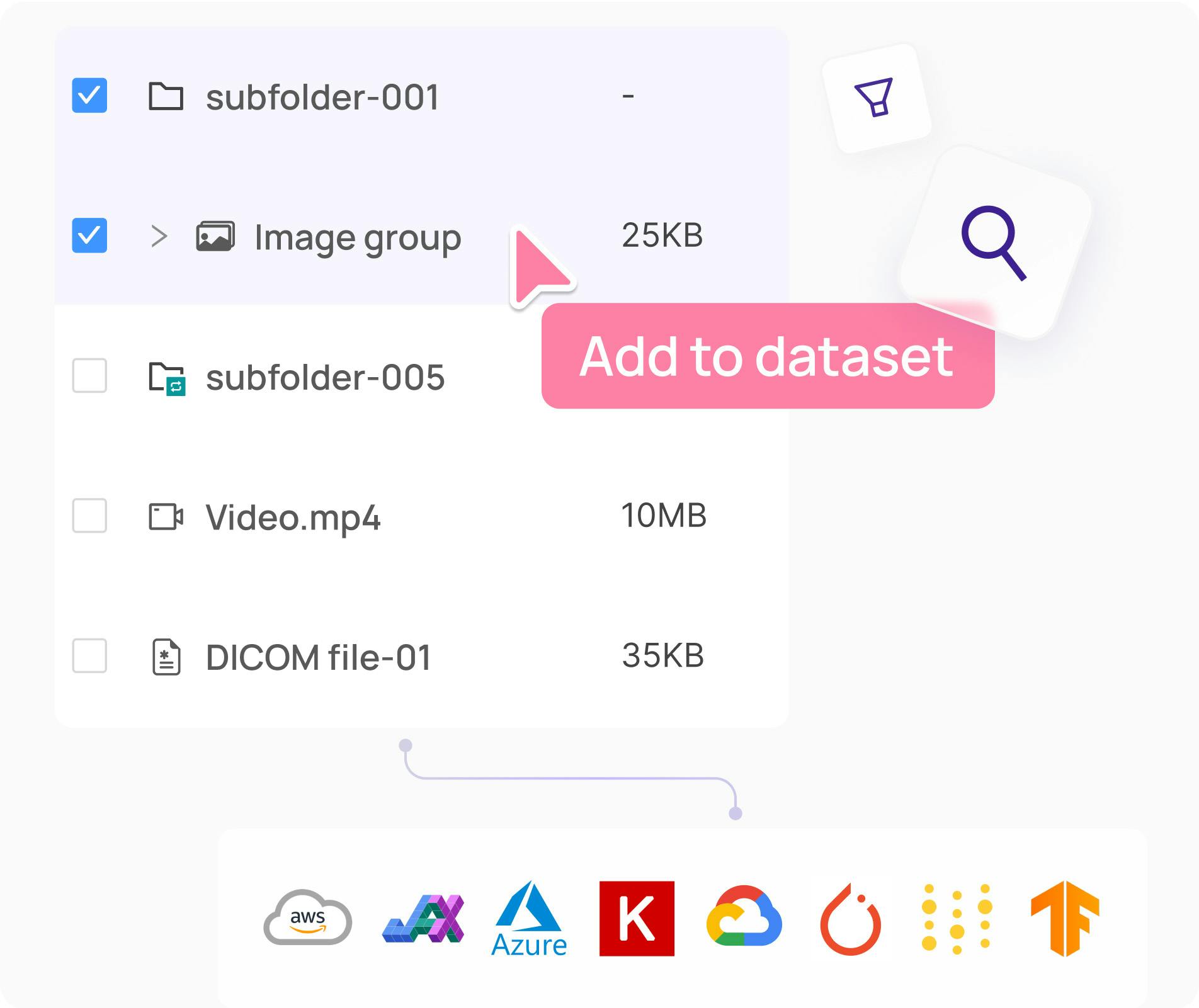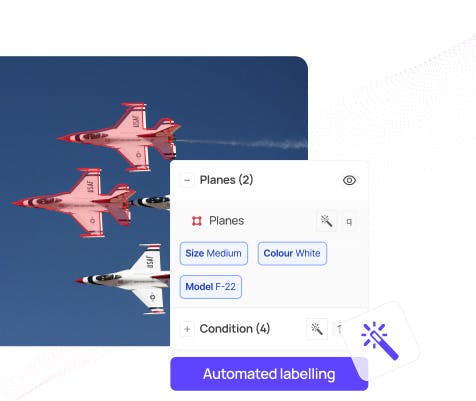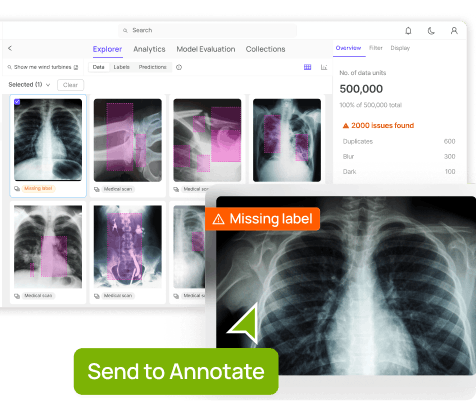Contents
What Is Video Annotation in Logistics?
Why Video Annotation Matters for Logistics AI
Key Features to Look for in a Logistics Video Annotation Tool
The Best Video Annotation Tools for Logistics
Video Annotation for Logistics: Key Takeaways
Encord Blog
Best Video Annotation Tools for Logistics 2025
5 min read

This guide to video annotation tools for logistics breaks down the essentials of turning raw video data into actionable AI insights with real-world use cases, top annotation platforms, and key features that boost accuracy, automation, and operational efficiency.
Artificial Intelligence (AI) is transforming the logistics industry by bringing in high levels of efficiency, safety, and operational insight like never seen before. As warehouses, distribution centers, and transportation networks largely depend upon visual data, i.e. from security cameras to drone footage, the need to accurately understand and make use of this data is very important.
The logistics industry deals with an enormous amount of video data every single day, capturing crucial activities such as package handling, vehicle movements, inventory stocking, and workforce operations. To truly leverage the power of AI, this raw visual data needs to be transformed into structured insights that AI models can comprehend and analyze. This is where video annotation becomes important.
Video annotation involves labeling of video data to identify and track objects, recognize actions, and highlight significant events. This annotated video data is essential for machine learning (ML) models. The ML model trained on this data enables various tasks in logistics such as real-time asset tracking, predictive maintenance, automated inventory management, and compliance monitoring etc.
So, picking the right video annotation tool is a crucial decision. The success of AI applications in logistics heavily relies on the accuracy of annotations, the efficiency of workflows, and how well the tool integrates with existing systems. The best annotation tools not only make the labeling process easier but also ensure high-quality annotations, support collaborative workflow management, and integrate smoothly with current logistics systems.

Video annotation example in Encord
What Is Video Annotation in Logistics?
In logistics setup, video annotation is the process of labeling, tracking, and segmenting objects or events captured in video data. It transforms raw visual data into structured datasets that are suitable for training ML models. Logistics operations have specific annotation requirements, such as accurately tracking multiple moving objects (e.g., packages, vehicles, forklifts), monitoring vehicle flow in busy distribution centers, handling packages efficiently, and precisely detecting significant operational events.
For example, a video stream can be annotated to track package handovers from one employee to another, identify loading and unloading sequences at docks, monitor inventory movement on warehouse shelves, and flag anomalies or potential safety hazards in real-time. The ML model trained on such annotated video data optimizes operational processes, enhances security measures, and reduces the human error that ultimately leads to a smarter and more efficient logistics process.
Why Video Annotation Matters for Logistics AI
In logistics, AI systems depend fundamentally on annotated video data. To determine how effectively the AI model can perform in a real-world environment, the quality and accuracy of these annotations is very important. High-quality annotations ensure that AI models are trained well and can precisely detect, interpret, and predict critical logistics tasks. Such models lead to significant improvements in the efficiency of the logistics operations. The relationship between annotation quality and AI outcomes in logistics is direct and powerful for the following reasons:
- Accuracy of Object Detection: AI systems trained on accurately annotated videos can detect and track packages, vehicles, workers, and equipment etc. accurately. Even minor inaccuracies in labeling can result in misidentification or tracking errors, potentially disrupting the entire supply chain operation.
- Route Optimization: High-quality annotations enable AI models to accurately identify patterns in vehicle movements and identify and track delays, congestion, or inefficiencies in warehouse flows. Accurate annotation ensures the AI can recommend better routes and optimize vehicle scheduling to reduce or remove delays.
- Event Recognition: Clear and accurate annotation of key events (such as package drop-off, pick-up, delays, or security breaches) allows AI systems to learn and detect anomalies promptly and improve response times and operational reliability.
Following are the common AI use cases in logistics that rely on accurate video annotations:
Automated Parcel Tracking
Annotated video data helps AI track packages throughout sorting centers, warehouses, and delivery vehicles. By accurately annotating each handover or movement, AI models become capable of real-time tracking. This improves tracking of package movements in the logistic workflow. It reduces errors due to manual tracking and ensures timely deliveries.
Forklift and Vehicle Navigation
Video annotations that involve annotation of navigation routes, vehicle movements, obstacles, and worker paths are important for training AI powered autonomous forklifts and vehicles. Accurately annotated data enables safe navigation, operational efficiency, and smooth interactions between humans and machines. This helps to minimize workplace accidents and streamline the processes.
Inventory and Shelf Monitoring
Accurately annotated video data of warehouse shelves and storage areas allows AI models to accurately assess inventory levels, spot out-of-stock items, and automatically initiate replenishment workflows. These precise annotations enhance predictions, improve inventory accuracy, and help maintain optimal stock levels.
Security and Safety Incident Detection
Annotating incidents like unauthorized access, falls, collisions, or protocol breaches helps train AI models that can accurately identify and respond to these events. High-quality annotations ensure that AI systems can quickly alert personnel, helping to prevent accidents, theft, and reduce liabilities.
Predictive Maintenance via Video Streams
AI models can predict potential failures or maintenance needs before they arise. It requires annotated video data to monitor machinery conditions, vehicle performance, or environmental factors. Accurate annotations of such data is important for differentiating between normal operating conditions and early-stage anomalies. This helps to minimize downtime and lower maintenance costs.
Key Features to Look for in a Logistics Video Annotation Tool
When choosing a video annotation tool specifically for training AI models for logistics applications, it is important to understand the unique demands of logistics workflows. The following are the essential features of a video annotation tool that has to be used to prepare dataset for training AI models for logistic applications.
Multi-object and Multi-class Tracking
In logistics, operational scenes often include multiple objects and classes simultaneously such as parcels, workers, forklifts, delivery vehicles, and various equipment moving dynamically in complex environments. A video annotation tool must:
- Enable simultaneous annotation and tracking of numerous objects across frames.
- Maintain consistent tracking IDs to accurately follow each object's trajectory.
- Provide easy labeling for different classes, clearly distinguishing between object types (e.g., “worker,” “forklift,” “parcel,” etc.).
- Allow quick review and adjustments to ensure consistent labeling, especially in crowded, fast-paced logistics hubs.

Multi-Object Tracking in Encord
Frame-accurate Event Tagging
In logistics processes various events must be precisely recognized, such as package pickups, deliveries, or anomaly detection like accidental drops or equipment malfunctions. Therefore a video annotation tool should:
- Allow annotators to pinpoint exact frames where an event occurs.
- Facilitate precise temporal annotations to clearly define the start and end times of events.
- Offer visual timelines or video playback control to ease frame-accurate tagging.

Event tagging in Encord using Dynamic Attribute
Flexible Workflow Management
Logistics operations generate large amounts of continuous video data from multiple cameras located at different points within facilities and across transportation routes. The video annotation tool must:
- Easily manage batch processing of thousands of video files or continuous video streams.
- Allow customizable workflows to suit different annotation tasks (e.g., simple object labeling versus detailed event annotations).
- Provide intelligent assignment of tasks, handling simultaneous inputs from multiple annotators seamlessly.

Collaboration and Quality Assurance (QA) Features
Annotation projects often involve distributed teams working remotely or from different locations. Thus, the tool should have strong collaborative capabilities:
- It should enable real-time collaborative annotation, allowing multiple annotators and reviewers to work concurrently without conflicts.
- Incorporate role-based access control so administrators can assign tasks, permissions, and project visibility.
- Include robust QA workflows, offering multi-stage annotation review, feedback loops, and clear audit trails.
- Provide version control and annotation histories to review edits, corrections, and improve accountability across teams.
Scalability
A typical logistics annotation project involves annotating potentially thousands of hours of video footage that demand substantial scalability. Therefore the video annotation tool must:
- Support handling of extremely large-scale datasets without performance degradation.
- Offer cloud-based scalability to expand annotation resources quickly when data volumes increase.
- Provide features to automate repetitive workflows.
AI-assisted & Automated Annotation
AI assistance can accelerate annotation tasks and improve accuracy. It also reduces manual workload for repetitive scenes. COnsidering this, the good video annotation tool should:
- Incorporate pre-trained models to automate annotation of common objects and scenarios.
- Enable active learning loops, where annotation feedback continually refines AI suggestions for improved accuracy.
- Include auto-tracking for objects moving predictably to reduce manual annotation time.

AI-Assisted Annotation for All Your Visual Data in Encord
Annotation Types
Training AI models for Logistics scenarios often require flexible annotation formats depending on the complexity and precision. Therefore a video annotation too must provide following annotation types:
- Bounding Boxes: Ideal for simple, consistent tracking of objects like parcels, vehicles, or equipment.
- Polygonal Annotations: Essential for detailed shape annotation of irregularly-shaped packages, forklifts, equipment, or loading areas.
- Polyline Annotations: Useful for marking paths, conveyor belts, forklift trajectories, or route paths within warehouses or sorting centers.
- Key-point Annotation: Helpful for marking specific parts of objects or equipment (e.g., door handles, package labels, equipment parts for predictive maintenance). Keypoint annotation can also be used to annotate human workers to analyze their pose.

Selecting a video annotation tool equipped with these comprehensive features ensures that logistics AI systems receive the precise, reliable, and actionable data needed for training a robust AI model to improve optimal operational performance and strategic advantage.
The Best Video Annotation Tools for Logistics
Encord
Encord is a complete, enterprise-grade data annotation platform specifically built for managing large-scale, complex annotation tasks efficiently. It combines advanced automation, collaboration features, and a highly customizable workflow environment ideal for demanding logistics applications.
- Multi-object & Multi-class Tracking: Encord excels with robust multi-object tracking, maintaining precise IDs across frames, ideal for complex logistics scenarios involving numerous parcels, vehicles, and workers.
- Frame-accurate Event Tagging: Encord supports Dynamic Attributes annotations that enable accurate event identification (e.g., parcel handoffs, forklift movements, delivery drop-offs).
- Flexible Workflow Management: Encord offers workflow customization, task management, and easy integration into logistics systems, handling massive streams efficiently.
- Collaboration & QA Features: Encord provides strong team management, real-time collaboration, comprehensive review cycles, annotation history/versioning, and detailed QA workflows.
- Scalability: Encord is highly scalable cloud architecture capable of annotating thousands of hours of logistics footage efficiently.
- AI-assisted & Automated Annotation: Encord offers AI-assisted labeling, active learning, and auto-tracking capabilities to improve annotation efficiency.
- Annotation Types: Encord supports bounding boxes, polygons, polylines, keypoints, segmentation masks which are essential for logistics annotation needs.

AI-Assisted Video annotation in Encord
CVAT (Computer Vision Annotation Tool)
CVAT is an open-source data annotation platform with support for video annotation. It is popular among researchers and businesses due to its flexibility, user-friendly interface, and robust annotation capabilities. It is particularly suitable for teams requiring customizable solutions.
- Multi-object & Multi-class Tracking: CVAT supports multi-object tracking with interpolation between frames which is suitable for moderately complex logistics use cases.
- Frame-accurate Event Tagging: CVAT offers detailed timeline controls for precise event labeling.
- Flexible Workflow Management: CVAT requires some setup for handling extensive datasets or complex logistics workflows.
- Collaboration & QA Features: CVAT supports basic collaboration with task assignment and review cycles. However, enterprise-level QA features may require custom setup.
- Scalability: CVAT has good scalability for medium-sized projects. The large-scale logistics operations might require custom infrastructure tuning.
- AI-assisted & Automated Annotation: CVAT offers basic auto-labeling via external integrations and support for automatic interpolation between keyframes.
- Annotation Types: CVAT provides bounding boxes, polygons, polylines, and segmentation masks which are flexible for diverse logistics scenarios.

Supervisely
Supervisely is a versatile AI data labeling platform emphasizing collaboration, automation, and ease-of-use. Known for its intuitive interface and robust tracking features, Supervisely is a good choice for teams looking to manage smooth annotation workflows.
- Multi-object & Multi-class Tracking: Supervisely supports advanced multi-object tracking and labeling objects across video frames.
- Frame-accurate Event Tagging: Supervisely provides video timeline annotation tools for precise event marking like parcel deliveries or inventory checks.
- Flexible Workflow Management: Supervisely has rich customization options and workflow automation features for complex logistics operations as well as multiple concurrent projects.
- Collaboration & QA Features: Supervisely provides strong collaborative environment, task management, real-time annotation review, feedback loops, and QA.
- Scalability:Supervisely offers scalable cloud-based infrastructure to support large video annotation projects.
- AI-assisted & Automated Annotation: Supervisely has strong AI-assistance capabilities, including object detection models, tracking automation, and active learning integration.
- Annotation Types: Supervisely supports bounding boxes, polygons, keypoints, polylines, segmentation masks.

Video Annotation in Supervisely
Kili Technology
Kili Technology is an advanced annotation platform emphasizing scalability, automation, and integration capabilities. Built for enterprise deployments, Kili excels in handling complex annotation workflows and integrates seamlessly with AI model training pipelines in logistics environments.
- Multi-object & Multi-class Tracking: Kili supports multi-class labeling effectively and its multi-object tracking capabilities are good for logistics tasks with moderate complexity.
- Frame-accurate Event Tagging:Kili has precise temporal annotation capabilities for accurately labeling logistics events.
- Flexible Workflow Management: Kili supports highly customizable workflows and APIs for integration with model training pipelines.
- Collaboration & QA Features: Kili has extensive collaborative features, including detailed project and task management, annotation reviews, and annotation-quality analytics.
- Scalability: Kili is highly scalable and is designed specifically for enterprise-grade annotation tasks for large-scale annotation projects.
- AI-assisted & Automated Annotation: Kili offers robust auto-labeling, automated annotation via built-in or custom AI models which improves annotation efficiency.
- Annotation Types: Kili has rich support for bounding boxes, polygons, segmentation masks, and other logistics-relevant annotation formats.

Label Studio
Label Studio is an open-source, highly customizable annotation tool supporting multiple data formats. It appeals especially to teams seeking flexibility and custom integration options, making it ideal for logistics scenarios with specific workflow needs.

Video annotation in Label Studio
- Multi-object & Multi-class Tracking: Label Studio supports multi-class labeling. However, tracking across video frames requires plugins or additional customization.
- Frame-accurate Event Tagging: Label Studio has good temporal tagging capabilities. It is especially suitable for simpler event annotations. The highly precise frame-level annotation requires custom setups.
- Flexible Workflow Management: Label Studio facilitates data labeling workflows by enabling teams to efficiently manage projects, configure interfaces, and leverage machine learning to automate labeling tasks.
- Collaboration & QA Features: Label Studio has basic collaboration built-in, with task assignment and reviews; advanced QA features need additional configurations.
- Scalability: Label Studio's scalability support is enhanced by its compatibility with technologies like Kubernetes and Helm and integration with storage solutions like Azure Blob Storage (ABS). These integrations enable easy scaling of the Label Studio platform to handle large datasets and annotation tasks.
- AI-assisted & Automated Annotation: Label Studio utilizes AI-assisted labeling through its ML Backend integration, enabling interactive pre-annotations.
- Annotation Types: Label Studio supports different annotation types, including bounding boxes, polygons, polylines, and keypoints, offering good logistics annotation coverage.
Labelbox
Labelbox is an industry-leading annotation solution known for its powerful AI-assisted labeling, enterprise-level scalability, and collaboration. Designed to accelerate the annotation lifecycle, Labelbox suits logistics enterprises aiming for efficiency, scalability, and accuracy.

- Multi-object & Multi-class Tracking: Labelbox provides robust multi-object and multi-class annotation, supporting effective tracking of logistics-specific scenarios like warehouse movements.
- Frame-accurate Event Tagging: Labelbox has precise event annotations with detailed frame-level tagging tools, ideal for logistics event recognition tasks.
- Flexible Workflow Management: Labelbox is highly flexible with customizable workflows, suitable for integration with complex operational data pipelines.
- Collaboration & QA Features: Labelbox provides excellent team collaboration, version control, annotation reviews, and detailed QA processes, aligning with logistics operation needs.
- Scalability: Labelbox has a strong scalability feature capable of handling extensive logistics annotation projects without performance issues.
- AI-assisted & Automated Annotation: Comprehensive AI-powered annotation and tracking tools significantly improving annotation speed and accuracy.
- Annotation Types: Offers a wide range of annotation types (bounding boxes, polygons, polylines, keypoints, segmentation masks) fully compatible with logistics use cases.
Labellerr
Labellerr is a user-friendly, accessible annotation platform designed to simplify the labeling process for medium-scale data projects. Its straightforward interface and moderate AI-assistance make it suitable for smaller to mid-size logistics operations.

- Multi-object & Multi-class Tracking: Labellerr provides solid multi-class labeling support for complex scenes as well as multi-object tracking effective for simpler scenarios.
- Frame-accurate Event Tagging: Labellerr has good support for temporal tagging, suitable for clearly defined logistics events. It may lack advanced timeline controls for very complex scenarios.
- Flexible Workflow Management: Labellerr supports workflow management for mid-scale logistics applications; might need additional configuration for very complex pipelines.
- Collaboration & QA Features: Labellerr provides basic to moderate collaboration and QA features, suitable for small to medium-sized annotation projects.
- Scalability: Labellerr is scalable for medium-sized logistics operations. It may require additional infrastructure for large-scale datasets.
- AI-assisted & Automated Annotation: Labellerr supports AI assisted annotation to speedup data annotation tasks..
- Annotation Types: Labellerr Supports essential annotation types (bounding boxes, polygons, keypoints) suitable for a range of logistics annotation needs.
Video Annotation for Logistics: Key Takeaways
This blog highlights how video annotation plays a crucial role in building effective AI systems for logistics operations. Here are the core insights from this blog:
- Video Annotation Transforms Visual Data into Insights: In logistics, large volumes of video data from cameras are collected daily. Annotating this data is essential for training machine learning (ML) models that enable automation, tracking, and operational intelligence.
- Logistics-Specific Use Cases Require Precision: Applications such as real-time parcel tracking, forklift navigation, inventory monitoring, security incident detection, and predictive maintenance all rely on high-quality, frame-accurate video annotations.
- Annotation Quality Impacts AI Performance: Accurate annotations directly influence object detection, event recognition, and route optimization, enabling AI to make precise predictions and reduce errors in logistics workflows.
Choosing the right annotation tool is essential for building accurate and scalable logistics AI systems, and the tools listed offer various strengths tailored to different logistics needs.
Explore the platform
Data infrastructure for multimodal AI
Explore product
Explore our products
- Video annotation in logistics refers to labeling objects, events, or actions in video footage—such as tracking parcels, identifying forklift paths, or detecting safety incidents—to create structured data used for training AI and machine learning models.
- AI models depend on annotated video data to learn how to detect and interpret real-world logistics activities. High-quality annotations improve model accuracy for tasks like real-time parcel tracking, anomaly detection, route optimization, and predictive maintenance.
- Parcel tracking across warehouses and delivery routes Forklift and vehicle navigation in dynamic environments Inventory and shelf monitoring for real-time stock updates Safety and security incident detection Predictive maintenance by identifying early signs of wear and malfunction
- Multi-object and multi-class tracking Frame-accurate event tagging Scalable and flexible workflow management Real-time collaboration and QA tools AI-assisted annotation (e.g., auto-tracking, pre-labeling) Support for various annotation types (bounding boxes, polygons, keypoints, etc.)
- For logistics-focused video annotation—where precision, scalability, and team collaboration are critical—Encord stands out as the best overall tool. Encord offers a robust set of features tailored for complex, real-world logistics environments


